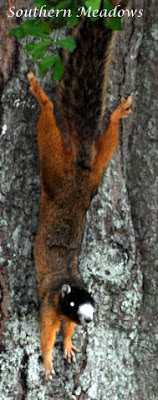Wildflower Wednesday: Aromatic Aster
Fall has finally arrived in Northeast Georgia. Persistently cooler temperatures set the tone this week for autumn, while the threat of frost on Sunday had us in a tizzy; hauling in the house plants that had enjoyed a summer hiatus in the garden, back indoors. Despite the recent lack of rain, the October garden has come alive with prolific autumn blooms. Our native asters are stealing the show.
In his book Bringing Nature Home Doug Tallamy describes asters as one of the top wildflowers that supports the most species of butterflies and moths. Not only do asters give color to our bright autumn days, but they are essential in supporting a variety of native bees, flies and butterflies that are active later in the year.
When we designed the wildlife hedgerow that sits above the retaining wall, which runs alongside the front driveway, we included several native asters as forage habitat for pollinators and songbirds. Several varieties of asters have been very productive over the past two growing seasons and filled in nicely.
The aromatic aster (Symphyotrichum oblongifolious) has been a standout. Thriving in the drier soil on this sloped terrain, it puts on quite a show for all those who drive by. This year it spilled over the retaining wall, creating a dramatic effect, but probably could have benefited from some mid-summer pruning.
Enjoying full sun, this aster is outfitted in blue blooms that dazzle the pollinators. The sound of buzzing bees is thunderous almost as if one where inside a hive. A closer look reveals a variety of bees from the more bodacious carpenter bees to the tiniest of sweat bees.
A wealth of butterflies flutter from one bloom to the next, dipping their long proboscis into the disk florets. Skippers are especially frequent visitors, but the aromatic aster also lures medium size butterflies with its sweet nectar.
Syrphid flies that mimic bees also seek nectar and pollen. One could sit for hours being entertained by the diversity of pollinators this aster supports.
While all of these insects are foraging, they are providing important pollination services to the plant. Later in the season, game birds and song birds will feast on the seeds.
In his book Bringing Nature Home Doug Tallamy describes asters as one of the top wildflowers that supports the most species of butterflies and moths. Not only do asters give color to our bright autumn days, but they are essential in supporting a variety of native bees, flies and butterflies that are active later in the year.
When we designed the wildlife hedgerow that sits above the retaining wall, which runs alongside the front driveway, we included several native asters as forage habitat for pollinators and songbirds. Several varieties of asters have been very productive over the past two growing seasons and filled in nicely.
The aromatic aster (Symphyotrichum oblongifolious) has been a standout. Thriving in the drier soil on this sloped terrain, it puts on quite a show for all those who drive by. This year it spilled over the retaining wall, creating a dramatic effect, but probably could have benefited from some mid-summer pruning.
Syrphid flies that mimic bees also seek nectar and pollen. One could sit for hours being entertained by the diversity of pollinators this aster supports.
While all of these insects are foraging, they are providing important pollination services to the plant. Later in the season, game birds and song birds will feast on the seeds.
The Aromatic aster is an excellent landscape plant, prairie plant and habitat restoration species. It is extremely adaptable, growing happily in sandy, rocky and clay soils. It is drought tolerant, which is always a bonus in my book. Makes a great ground cover and is a host plant to several butterfly and moth species.
*Symphyotrichum oblongifolious is native to most Southeastern States (excluding Georgia and South Carolina).
*Symphyotrichum oblongifolious is native to most Southeastern States (excluding Georgia and South Carolina).












.png)
